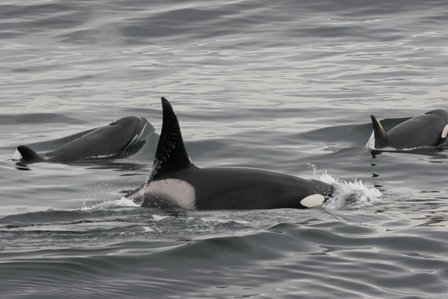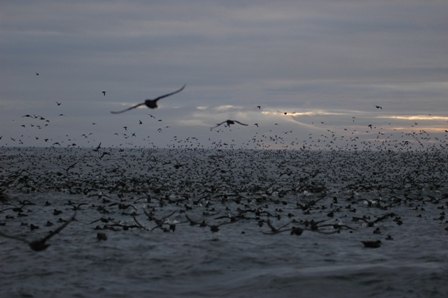by Nate Jones, Vertebrate Ecology Lab
(Note: I last posted about my Alaskan surveys loooong ago in October, with a post about how stormy it’d been out on the Bering Sea…)
10 June, 2008: Today has been marvelous. The storm had passed, and wildlife was everywhere! My seabird surveys are keeping me very busy, but the whales are stealing the show.
The ocean is impossibly calm, like glass; when I got up to the bridge to look out over the surroundings, it was difficult to tell even if the boat was moving – so smooth was its progress, and so monotonous is the gray sea surface. Spotting birds today has been a treat. Lots of little auklets, looking like buzzing avocados, their stubby wings flapping furiously. We also have had some good whale sightings. At least three Fin Whales… and two groups of Killer Whales have passed within viewing distance. It’s so peaceful here today. The ship’s engines just rumbling along, and only a very slight rocking under me to bring water to mind.

(Photo: NOAA/NMML)
And, then, this evening I had one of those peak life moments that I feel so privileged to experience: a feeding symphony of birds and whales
We had slowed for a trawl to try to catch some pollock (fish) to sample. It was going on about 10:30pm, and still plenty of dim light left in the day. Marty and I don’t survey for birds during trawls because the flocks of scavenging fulmars and gulls present during fishing exercises confound our estimates of what free-ranging birds are “normally” doing. So, I was done for the night.

But, we were fishing right on the north side of Unimak Pass, one of the larger gaps in the eastern Aleutian chain, and a major funnel through which water and animal life move between Pacific and Bering waters. There is often an abundance of marine life at these Aleutian passes, so I stuck around upstairs on the bridge to see what might show up…
The night shift junior officer in command prepped the bridge for night work by modifying all screens to red (night-vision), and plugging in an iPod for some electronica. He and I were the only ones left up top as the dusk deepened, and the driving dance club beats began to race. The ocean was quiet and smooth, and once again I had that feeling of floating through a gray other-world. In the distance I could see some fog-shrouded cliffs of remote Aleutian islands, and the gap between them that was Unimak Pass, the gateway to the Pacific Ocean. The next land beyond that portal was Hawai’i, 2250 miles further south!
I lingered there in the red-tinted lighting, looking out at one of the most productive marine hotspots on planet earth. The techno music raced in crescendo. Sitar riffs, sampled and remixed, dissolved my sense of time. We watched as tens of thousands of shearwaters massed and swirled in all directions across the horizons. Huge black clouds of them, billowing like smoke on the waters. They flooded across the bow of the ship in waves hundreds of birds deep.
Dozens of Humpback whales were surfacing and diving, throwing their flukes up high with every descent, blowing hard between feeding bouts. They were everywhere I looked, dotting the ocean with dim white plumes and leaving slick trace “footprints” of disturbed waters in their wakes.

Fulmars swirled in a frenzy where our fishing lines met the water. Hundreds of them, like aerial ants, swarmed the water looking for scraps. Two gigantic Laysan Albatrosses flapped laboriously in the still twighlight, circling our ship, no doubt anticipating a free meal when the nets were pulled up. Puffins huffed past us at bridge-eye level, about 40′ above the waterline. Murres disappeared, then surfaced to the south. The ocean was absolutely alive. It was boiling with birds, heaving with whales, nearly prehistoric, overwhelming. I stayed for over two hours as darkness slowly took my views away. I couldn’t believe how lucky I was to be alive.


